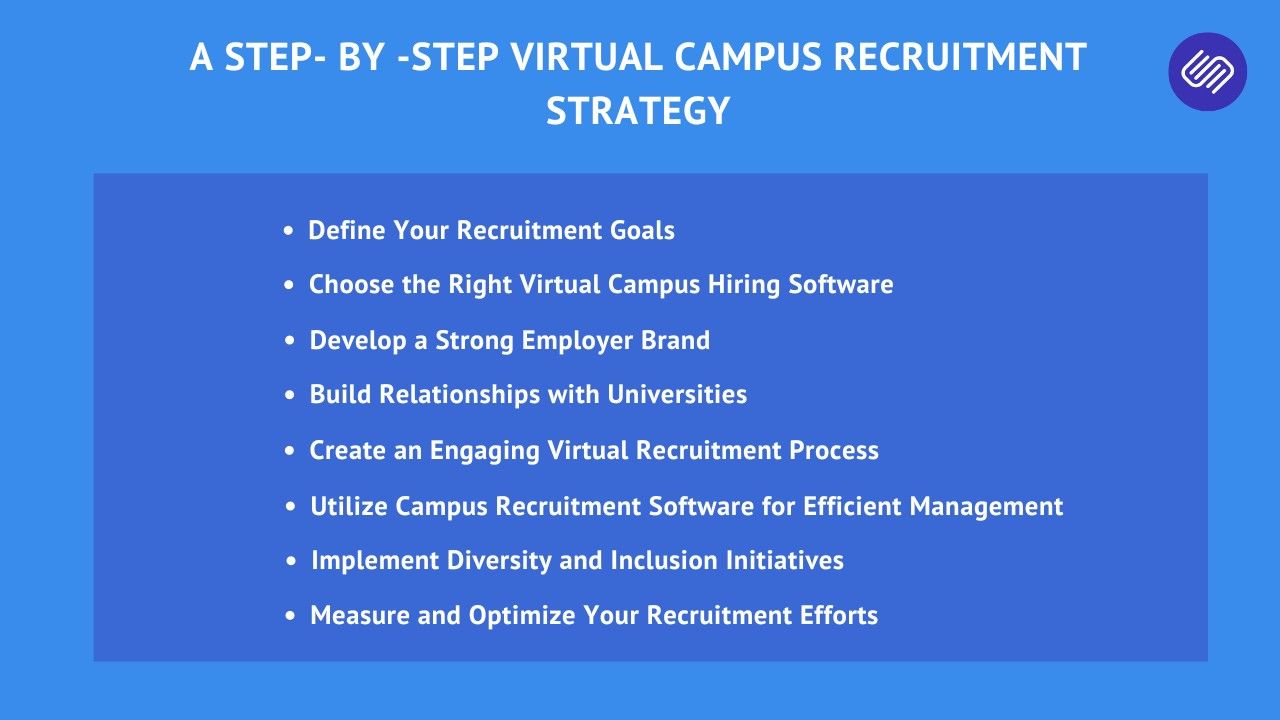The recruitment landscape has evolved significantly, with virtual campus recruitment becoming a pivotal strategy for organizations aiming to tap into fresh talent. For corporate HR managers, developing a robust virtual campus recruitment strategy is essential to attract, engage, and hire the best candidates. This guide provides a comprehensive, step-by-step approach to building an effective virtual campus recruitment strategy, ensuring your organization stays competitive in the talent market.
Understanding Virtual Campus Recruitment
Virtual campus recruitment refers to engaging with and hiring students or recent graduates through online platforms. This approach leverages technology to connect with potential candidates, eliminating geographical barriers and reducing costs associated with traditional on-campus recruitment drives. Virtual campus recruitment not only broadens your talent pool but also allows for a more efficient and streamlined recruitment process. With advancements in technology, virtual recruitment platforms offer features such as video interviews, online assessments, and real-time analytics, making it easier to identify and hire the right candidates.

Step 1: Define Your Recruitment Goals
The first step in building a robust virtual campus recruitment strategy is clearly defining your recruitment goals. Consider the following questions:
- What positions are you looking to fill?
- What skills and qualifications are required?
- What is your timeline for hiring?
- What are your diversity and inclusion objectives?
Having clear goals will guide your recruitment efforts and help you measure success. For example, if your goal is to hire 50 software engineers within six months, you’ll need to tailor your recruitment strategy to target computer science programs and tech-savvy students. Additionally, setting specific diversity targets can help ensure a more inclusive hiring process.
Step 2: Choose the Right Virtual Campus Hiring Software
Selecting the appropriate virtual campus hiring software is crucial for the success of your recruitment strategy. The right software can streamline the recruitment process, enhance the candidate experience, and provide valuable insights. Look for features such as:
- Seamless integration with your existing HR systems
- User-friendly interface for both recruiters and candidates
- Robust analytics and reporting capabilities
- Support for video interviews and virtual career fairs
One of the most popular virtual campus hiring software is Superset. It helps fresh graduates get their first jobs, enables employers to recruit faster, and helps colleges streamline campus placements
Step 3: Develop a Strong Employer Brand
A compelling employer brand is essential to attract top talent. Your employer brand should reflect your organization’s values, culture, and the benefits of working with you. Here are some tips to develop a strong employer brand:
- Create engaging content that showcases your company culture, employee stories, and career development opportunities.
- Leverage social media platforms to reach and engage with students.
- Collaborate with university career services to promote your brand on campus.
For example, creating a series of videos featuring employee testimonials and day-in-the-life segments can provide candidates with a genuine glimpse into your company culture. Additionally, hosting virtual events such as webinars and Q&A sessions with current employees can further engage and inform potential candidates.
Step 4: Build Relationships with Universities
Establishing strong relationships with universities is a key component of a successful virtual campus recruitment strategy. Partner with university career centres, faculty, and student organizations to create awareness about your organization and recruitment opportunities. Consider the following approaches:
- Sponsor university events, workshops, and webinars
- Participate in virtual career fairs
- Offer internships and co-op programs
- Engage with students through mentorship programs and guest lectures
For instance, sponsoring a university’s tech conference or hackathon can help position your organization as a leading employer in the tech industry. Offering internships and co-op programs not only provides students with valuable work experience but also allows you to evaluate potential candidates for full-time positions.
Step 5: Create an Engaging Virtual Recruitment Process
An engaging virtual recruitment process can set you apart from competitors. Here are some steps to ensure a smooth and interactive process:
- Develop a comprehensive recruitment plan that outlines each stage of the process, from application to onboarding.
- Use virtual hiring solutions to conduct video interviews, assessments, and virtual career fairs.
- Provide candidates with a clear timeline and regular updates on their application status.
- Offer virtual office tours and Q&A sessions with current employees to give candidates a glimpse into your organization.
For example, incorporating gamification into your recruitment process, such as online challenges or hackathons, can make the process more engaging and fun for candidates. Providing timely feedback and maintaining open communication throughout the process can also enhance the candidate experience.
Step 6: Utilize Campus Recruitment Software for Efficient Management
Implementing campus recruitment software can significantly enhance the efficiency of your recruitment process. This software can help you manage candidate applications, schedule interviews, and track recruitment metrics. Key features to look for include:
- Applicant tracking system (ATS) integration
- Automated communication tools
- Customizable workflows and pipelines
- Real-time data analytics and reporting
Using campus recruitment software allows you to centralize and automate various aspects of the recruitment process, reducing administrative burden and improving overall efficiency. For instance, automated communication tools can ensure timely follow-ups with candidates, while real-time analytics can provide insights into the effectiveness of your recruitment efforts.
Step 7: Implement Diversity and Inclusion Initiatives
Diversity and inclusion are critical components of a successful recruitment strategy. Ensure your virtual campus recruitment efforts are inclusive and reach a diverse pool of candidates. Consider the following initiatives:
- Partner with universities that have a diverse student population
- Offer scholarships and internships to underrepresented groups
- Implement bias training for recruiters and hiring managers
- Use blind resume screening tools to reduce unconscious bias
Offering scholarships and internships to underrepresented groups can also help support diversity initiatives. Additionally, implementing bias training and using blind resume screening tools can help reduce unconscious bias in the recruitment process.
Step 8: Measure and Optimize Your Recruitment Efforts
Measuring the success of your virtual campus recruitment strategy is essential for continuous improvement. Use the analytics and reporting capabilities of your campus recruitment software to track key performance indicators (KPIs) such as:
- Number of applications received
- Candidate engagement levels
- Time-to-hire
- Offer acceptance rates
- Diversity metrics
Regularly review these metrics to identify areas for improvement and adjust your strategy accordingly. For instance, if you notice a high drop-off rate during the interview stage, you may need to re-evaluate your interview process or provide additional support to candidates. Continuous monitoring and optimization of your recruitment efforts can help ensure long-term success.
Advantages of Virtual Campus Recruitment
Cost Efficiency
One of the most significant advantages of virtual campus recruitment is cost efficiency. Traditional recruitment processes involve travel, accommodation, and logistical expenses for campus visits. In contrast, virtual recruitment eliminates these costs, allowing companies to allocate their budget more effectively.
Broader Reach
Virtual campus recruitment enables organizations to reach a wider audience. Without geographical constraints, companies can engage with students from universities across the globe. This broader reach increases the chances of finding the best talent and enhances diversity in the candidate pool.
Flexibility and Convenience
Virtual recruitment offers greater flexibility for both recruiters and candidates. Online platforms allow for asynchronous communication, enabling candidates to participate in interviews and assessments at their convenience. This flexibility can lead to higher candidate satisfaction and engagement.
Enhanced Data and Analytics
Advanced virtual recruitment platforms provide robust data and analytics capabilities. HR managers can track and analyze various metrics, such as application rates, candidate engagement, and time-to-hire. These insights help optimize the recruitment process and make data-driven decisions.
Improved Candidate Experience
Virtual recruitment processes, when designed effectively, can offer a seamless and positive candidate experience. Features like virtual office tours, interactive assessments, and timely communication contribute to a better overall experience. Satisfied candidates are more likely to accept job offers and recommend the company to peers.
Conclusion
Building a robust virtual campus recruitment strategy requires careful planning, the right tools, and a commitment to continuous improvement. By following this step-by-step guide, corporate HR managers can effectively attract, engage, and hire top talent from universities across the globe. Embrace the power of virtual campus recruitment, leverage advanced virtual hiring solutions, and optimize your campus recruitment process to stay ahead in the competitive talent market.








